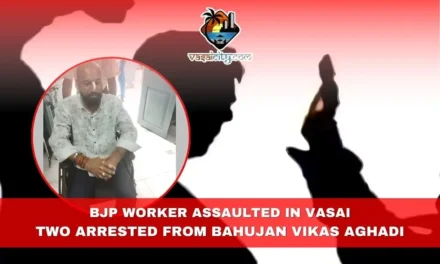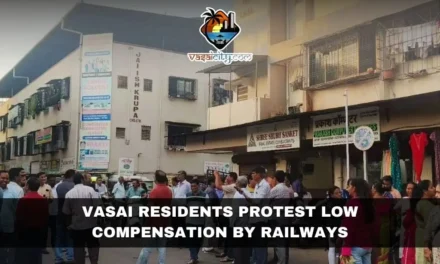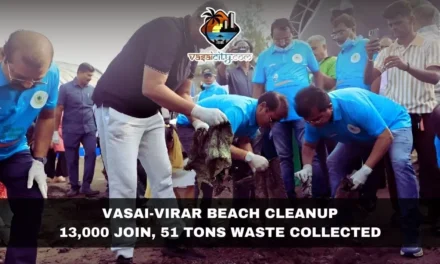In a breakthrough development, the Mira Bhayandar-Vasai Virar (MBVV) police have finally arrested a chawl builder who managed to evade capture for nearly two years. The individual in question, identified as Vaikunth Brijraj Mishra, faces charges related to deceiving unsuspecting home seekers by enticing them with affordable tenements in the Vasai-Naigaon region.
Mishra’s modus operandi involved alluring potential home buyers with the promise of economical 300 square feet rooms within under-construction chawls, offered through an installment payment system. The arrest came on the heels of a complaint filed by one victim who fell prey to Mishra’s schemes, losing ₹2.50 lakh in the process. Mishra had assured the victim possession of the room for ₹4 lakh, and the victim paid the amount in installments from 2018 to 2022. However, neither the promised room materialized nor did Mishra refund the money before going underground. Efforts by the police to trace him proved futile initially, as he had shut down all his mobile numbers.
The breakthrough occurred during a renewed effort by the police to locate absconding criminals. A team, led by API Sachin Sanap under the guidance of senior police inspector Jairaj Ranawre, received a tip-off indicating Mishra’s presence in Virar. The police set a trap and successfully apprehended him at Cosmos Building, where he had remained holed up, rarely venturing outside his apartment, anticipating arrest for almost two years.
Subsequent investigations uncovered Mishra’s involvement in three additional cases where he duped home seekers using a similar modus operandi. The alleged lack of action by authorities against the chawl-builder mafias operating in the Vasai-Virar belt has created an environment conducive to cheating potential buyers, primarily from the lower economic strata, with promises of affordable housing.
The arrest of Mishra sheds light on the challenges faced by individuals seeking modest accommodation in the Vasai-Naigaon belt. Mishra’s offer of inexpensive rooms in under-construction chawls seemed like a lifeline for those with limited financial means. The installment payment system, while appearing convenient, ultimately became a trap for victims like the one who lost ₹2.50 lakh.
The victim’s complaint served as the catalyst for the police’s renewed efforts to bring Mishra to justice. The ordeal began in 2018 when the victim, optimistic about securing affordable housing, entered into an agreement with Mishra. The promise of a 300 square feet room for ₹4 lakh seemed like a dream come true, especially for someone navigating the challenges of a limited budget.
However, as time passed, the victim found themselves entangled in a web of false assurances. Despite diligently making payments over the course of four years, the victim never received the promised room. Mishra’s disappearance further compounded the victim’s predicament, leaving them without the room or the hard-earned money invested in installments.
Mishra’s ability to remain elusive for such an extended period raises questions about the challenges faced by law enforcement in tracking down individuals involved in deceptive practices. His strategic move to switch off all his mobile numbers proved effective in eluding initial attempts by the police to locate him. This underscores the need for more robust investigative techniques to tackle individuals exploiting unsuspecting citizens.
The breakthrough in Mishra’s arrest showcases the perseverance of law enforcement, especially the efforts of the team led by API Sachin Sanap and senior police inspector Jairaj Ranawre. Acting on a tip-off, they meticulously planned and executed the operation that led to Mishra’s capture. The fact that Mishra had chosen to confine himself to his apartment in Cosmos Building highlights the fear and paranoia that had gripped him during his two-year run from the law.
As the investigations unfolded, it became evident that Mishra was not a one-time offender. Three additional cases of similar deception came to light, revealing a pattern of exploitation targeting vulnerable home seekers. The alleged inaction of authorities against the chawl-builder mafias operating in the Vasai-Virar belt contributed to the proliferation of such fraudulent activities. The lack of a decisive response allowed individuals like Mishra to take advantage of those who could least afford such financial setbacks.
The implications of Mishra’s arrest extend beyond the immediate resolution of the cases against him. It raises broader questions about the need for proactive measures to curb fraudulent practices in the real estate sector, particularly in regions where vulnerable populations are at risk. The Vasai-Naigaon belt, known for its lower economic strata, demands increased vigilance and swift action to protect residents from falling prey to deceptive schemes.
The arrest serves as a warning to other potential offenders and sends a message that law enforcement is committed to addressing issues related to deceptive practices in the real estate sector. However, it also underscores the importance of community awareness and education to empower individuals to make informed decisions when navigating the complex landscape of property transactions.
In conclusion, the arrest of Vaikunth Brijraj Mishra marks the end of a two-year evasion from justice. The case highlights the challenges faced by law enforcement in tackling deceptive practices in the real estate sector and emphasizes the need for a proactive approach to protect vulnerable individuals from falling victim to such schemes. As authorities work towards ensuring justice for the victims, the broader conversation around regulatory measures and community education becomes increasingly pertinent to prevent future occurrences of similar fraudulent activities.










